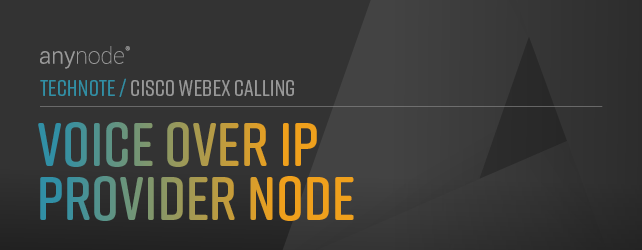
Voice over IP Provider Node
Video: VoIP provider node Configuration for Cisco Webex Calling with anynode – The Software SBC.
This chapter provides a comprehensive guide to the Voice over IP Provider node used in this configuration example. It contains the following and assisted configuration steps:
A brief overview of the key topics covered:
-
VoIP Provider/PSTN Preset: We explore the setup process for connecting with VoIP providers or Public Switched Telephone Network (PSTN) services. This includes configuring the necessary parameters and settings to establish communication with external networks.
-
Network Controller: We discuss the role of the Network Controller and its configuration. This component ensures smooth communication between the VoIP Provider node and the network infrastructure, managing connectivity and routing.
-
Ports: We examine the configuration of ports within the VoIP Provider node, including the setup of port numbers and protocols for inbound and outbound communication.
-
NAT Traversal: We examine the NAT Traversal dialog, which can be important for SIP communication between VoIP devices behind Network Address Translation (NAT).
-
SIP Interconnection: We show the SIP Interconnection dialog, which allows determining one of the two common options: Node Interconnection via SIP Trunking and Node as SIP Registration Client.
-
Remote SIP Domain: We discuss the setup of remote SIP domains, enabling communication with external SIP domains outside the local network.
-
Client Authentication: We explore the configuration of client authentication mechanisms to ensure secure access and prevent unauthorized use of the VoIP Provider node.
-
Proxy: We show the Proxy assistant dialog, which may act as an intermediary for SIP signaling, e.g., for load balancing or failover scenarios.
-
Asserted-URI: We discuss the configuration of Asserted-URI, which specifies the identity of the calling or a called party, ensuring accurate routing and identification.
-
Network Peer Whitelist: We examine the configuration of network peer whitelists, allowing for the definition of trusted IP addresses or ranges for secure communication.
-
Incoming Rewrite Rules: We explore the setup of rewrite rules for incoming calls, enabling customization and rewriting of call attributes, such as dial strings or caller ID's.
-
Outgoing Rewrite Rules: We explore the setup of rewrite rules for outgoing calls, enabling customization and rewriting of call attributes, such as dial strings or caller ID's.
-
Node Name: We cover the configuration of the node name, which serves as a unique identifier for the VoIP Provider node within the network.
-
Node Overview: The provided node configurations will be reviewed in the final assistant dialog.